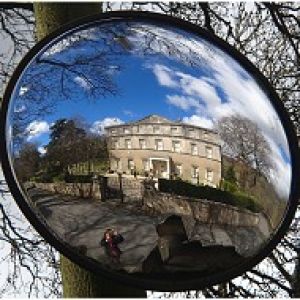Hidden Stroud XII The old Workhouse
...now known as Stone Manor and converted into private flats on top of Stroud hill, with fantastic views overlooking the town and the river Severn beyond. I've only been into two of the small flats, but they retain nothing of the Dickensian workhouse feel.
I intend to find out more about this building and its history, but I have to go out now. Watch this space! It's been at least ten weeks since I started wanting to capture this building. Thanks to CleanSteve's 'where to get a good shot' tips, I finally made it!
Some more info:
"Under the new [Poor Law Amendment] Act, [of 1834], the threat of the Union workhouse was intended to act as a deterrent to the able-bodied pauper. This was a principle enshrined in the revival of the "workhouse test" - poor relief would only be granted to those desperate enough to face entering the repugnant conditions of the workhouse. If an able-bodied man entered the workhouse, his whole family had to enter with him.
Life inside the workhouse was was intended to be as off-putting as possible. Men, women, children, the infirm, and the able-bodied were housed separately and given very basic and monotonous food such as watery porridge called gruel, or bread and cheese. All inmates had to wear the rough workhouse uniform and sleep in communal dormitories. Supervised baths were given once a week. The able-bodied were given hard work such as stone-breaking or picking apart old ropes called oakum. The elderly and infirm sat around in the day-rooms or sick-wards with little opportunity for visitors. Parents were only allowed limited contact with their children - perhaps for an hour or so a week on Sunday afternoon.
By the 1850s, the majority of those forced into the workhouse were not the work-shy, but the old, the infirm, the orphaned, unmarried mothers, and the physically or mentally ill. For the next century, the Union Workhouse was in many localities one of the largest and most significant buildings in the area, the largest ones accommodating more than a thousand inmates. Entering its harsh regime and spartan conditions was considered the ultimate degradation.
The workhouse was not, however, a prison. People could, in principle, leave whenever they wished, for example when work became available locally. Some people, known as the "ins and outs", entered and left quite frequently, treating the workhouse almost like a guest-house, albeit one with the most basic of facilities. For some, however, their stay in the workhouse would be for the rest of their lives."
This info comes from the excellent site which contains information about many UK workhouses.
Specific info about Stroud workhouse here
I found the 1881 census interesting, looking at occupants' former occupations, and that some were described simply as "imbecile". Ouch.
Troops were billeted here during World War II. The actual workhouse closed down in 1939, after being described as "a danger to sick people" because of the insanitary conditions. After the end of the war, the building remained derelict until being revamped and converted into flats in the 1990s.
One of my Facebook friends commented that she had heard that some local workmen refused to work on the site. What did they see, or hear?
And I wonder what it would be like to spend this New Year's Eve in overcrowded B&B "accommodation for homeless people?"
More Hidden Stroud shots

Comments
Sign in or get an account to comment.


